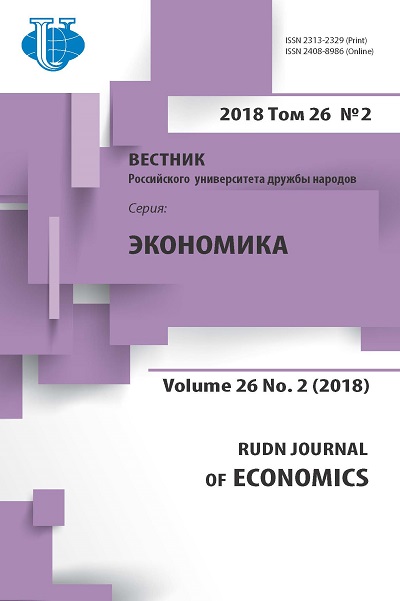MODERN STATE OF THE INSTITUTIONAL ENVIRONMENT OF THE REGION AS A FACTOR INFLUENCING THE OUTCOME FOREIGN INVESTMENTS
- Authors: Petrov NA1, Abramov DV1, Michailov AM1
-
Affiliations:
- Samara State University of economics
- Issue: Vol 26, No 2 (2018)
- Pages: 283-295
- Section: REGIONAL ECONOMY
- URL: https://journals.rudn.ru/economics/article/view/18906
- DOI: https://doi.org/10.22363/2313-2329-2018-26-2-283-295
Cite item
Full Text
Abstract
The article proves the impact of the institutional environment, investigated through the index of entrepreneurial confidence, the number of bankruptcies of enterprises, on the dynamics of economic variables, in particular, on the return on invested capital (ROIC), which is an indicator of business risk. It is determined that for foreign investors, this indicator of business risk is one of the key in the decision-making process to invest in the real sector of the economy. The authors argue that, under the current conditions of the Russian economy, debt restructuring and lending to enterprises belonging to a group of related persons in order to improve the value of ROIC is dangerous because of the further increase in overdue debts of enterprises.
About the authors
N A Petrov
Samara State University of economics
Author for correspondence.
Email: petrovnkt@gmail.com
Candidate of Economic Sciences, Associate Professor of the Samara State University of Economics
141, Soviet Army str, Samara, 443090, Russian FederationD V Abramov
Samara State University of economics
Email: saanecht@mail.ru
Candidate of Economic Sciences, Head. Department of World Economy, Samara State University of Economics
141, Soviet Army str, Samara, 443090, Russian FederationA M Michailov
Samara State University of economics
Email: 2427994@mail.ru
Doctor of Economics, Professor of the Department of Economic Theory of the Samara State University of Economics
141, Soviet Army str, Samara, 443090, Russian FederationReferences
- Abramov D.V., Bykova A.A. Problems of investment attractiveness of leading Russian regions and regions of European countries. Problems of improving the organization of production and management of industrial enterprises: interuniversity collection of scientific papers. Samara State University of Economics. 2017. № 1. P. 232—236. (in Russ).
- Azur D. It’s time to act. Finance and development. 2017. № 4 (54). P. 5—9. (in Russ).
- Bugakova N.S., Gelvanovsky M.I. Regions of Russia. Socio-economic indicators. 2017: P32 Stat. Sat. / Rosstat. M., 2017. 1402 p. (in Russ).
- Brigham U., Erhardt M. Financial management. 10 th ed. / Transl. with English. Ed. E.A. Dorofeeva. St. Petersburg: Peter, 2009. 960 p. (in Russ).
- Konovalova M.E., Larionov A.V. The role of intellectual capital in the current crisis of the banking system of the Russian Federation. Bulletin of the Samara State Economic University. 2017. No. 12 (158). P. 5—11. (in Russ).
- International Monetary Fund. Annual Report for 2017. Washington. 114 sec. [Electronic resource]. URL: http: //www.imf.org/external/pubs/ft/ar/2017/eng/pdfs/AR17-RUS.pdf (accessed: 16.02.2018).
- Mikhailov A.M. Evolution and interaction of factors of production in the process of changing technological methods of production. Economic sciences. 2016. No. 2 (135). P. 19—22. (in Russ).
- Petrov N.A., Mikhailov A.M. Impact of changes in the ratio of factors of production to cyclical development in the global economy. Monograph / N.A. Petrov, A.M. Mikhailov. Electron. Dan. Samara: Samara Publishing House. state. econ. Univ., 2017. 1 electron. opt. disk. (in Russ).
- Entrepreneurial climate in the Samara region: monitoring of factors and barriers to the development of small and medium-sized businesses in 2013. Research group “Free Opinion” [Electronic resource]. URL: http://www.gfso.ru/sites. Ver. from the screen (date of circulation: 16.02.2018).
- Results of operational monitoring of social and economic development of Russia and the subjects of the Russian Federation. № 13. Moscow: Situational Center of Social and Economic Development of Russian Regions. FGBOU HPE “RGU them. G.V. Plekhanov”, 2016. 138 p. (in Russ).
- Stewart, T.A. Intellectual Capital. The new Wealth of Organizations [Text] / T.A. Stewart. L.: Doubleday / Currency, 1997. 134 p.















